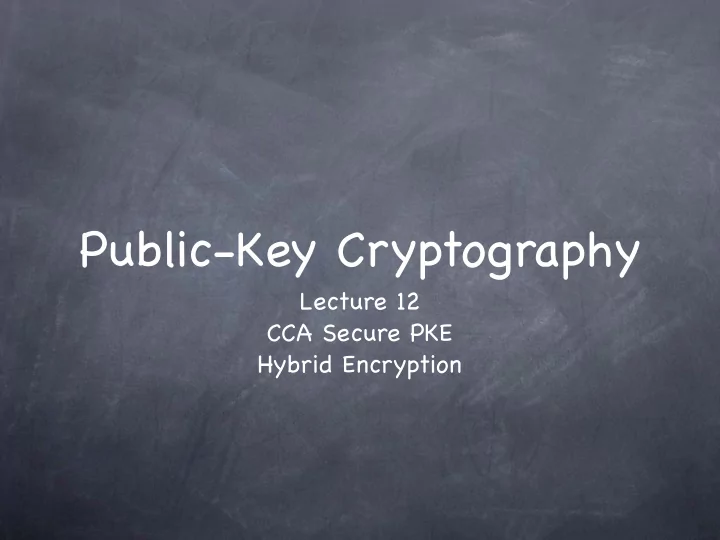

Public-Key Cryptography Lecture 12 CCA Secure PKE Hybrid Encryption
CCA Secure PKE In SKE, to get CCA security, we used a MAC Bob would accept only messages from Alice But in PKE, Bob wants to receive messages from Eve as well! But only if it is indeed Eve’ s “own message”: she should “know” her own message!
Chosen Ciphertext Attack Suppose Enc SIM-CPA secure A subtle Suppose encrypts a character at a e-mail attack time (still secure) I look around in everything... ! for your eyes shining Alice → Bob: Enc(m) I seek you Eve: Hack(Enc(m)) = Enc(m*) Hey Eve, (where m* = Reverse of m) Eve → Bob: Enc(m*) What’s this that you Bob → Eve: “what’s this: m*?” sent me? Eve: Reverse m* to find m! ...gnihtyreve ni > uoy kees I > gninihs seye ruoy rof > I look around dnuora kool I > for your eyes shining I seek you in everything...
Malleability Malleability: Eve can “malleate” a ciphertext (without having to decrypt it) to produce a new ciphertext that would decrypt to a “related” message More subtly, the 1 bit - valid or invalid - may leak information on message or SK E.g.: Malleability of El Gamal Recall: Enc (G,g,Y) (m) = (g x ,M.Y x ) Given (X,C) change it to (X,TC): will decrypt to TM Or change (X,C) to (X a ,C a ): will decrypt to M a If chosen-ciphertext attack possible i.e., Eve can get a ciphertext of her choice decrypted Then Eve can exploit malleability to learn something “related to” Alice’ s messages
Chosen Ciphertext Attack SIM-CCA: does capture this attack Key/ Key/ I look around Enc Dec in everything... ! for your eyes shining I seek you Hey Eve, What’s this that you sent me? ...gnihtyreve ni > uoy kees I > gninihs seye ruoy rof > I look around dnuora kool I > for your eyes shining I seek you in everything... Env !
SIM-CCA Security (PKE) PK/ SK/ Enc Dec Recv Send Replay Filter Secure (and correct) if: ∀ ∃ s.t. ∀ output of is distributed Env Env identically in REAL REAL and IDEAL IDEAL
CCA Secure PKE Schemes Several schemes in the heuristic “Random Oracle Model” RSA-OAEP Fujisaki-Okamoto DHIES (doesn’ t need the full power of ROM) Cramer-Shoup Encryption: Provably secure CCA scheme, under DDH assumption (next time) Hybrid Encryption schemes: Improving the efficiency of PKE
Random Oracle Model Random Oracle: a mythical oracle that, when initialized, picks a random function R:{0,1} * → {0,1} n(k) and when queried with x, returns R(x) All parties have access to the same RO In ROM, evaluating some “hash function” H would be modeled as accessing an RO Hope: the code for H has “no simple structure” and only way to get anything useful from it is to evaluate it on an input Sometimes security definitions need to be adapted for ROM Rigorous proofs of security, after moving to the ROM
Random Oracle Model There is no Pseudo-RO Unlike PRF , RO must be locally evaluable for all parties. (think: giving out the seed of a PRF) There are schemes secure in ROM, such that for any instantiation of the RO, the scheme is insecure! Also natural constructs/primitives which are realizable in ROM, but not in the standard model! What does a proof in ROM tell us? Secure against attacks that treat H as a blackbox (and for which H is pseudorandom)
RSA-OAEP RSA-OAEP “Text-book RSA encryption” (i.e., f RSA , the Trapdoor OWP candidate) applied to an “encoding” of the message Encoding is randomized Encoding uses a hash function modeled as a Random Oracle Security in the RO Model, assuming f RSA a OWP Part of RSA Cryptography Standard (PKCS#1 Ver 2.1). Commonly used in SSL/TLS implementations
Hybrid Encryption PKE is far less efficient compared to SKE (even in ROM) SKE using Block Ciphers (e.g. AES) and MAC is very fast RSA-OAEP uses modular exponentiations (Cramer-Shoup even more) Hybrid encryption: Use (CCA secure) PKE to transfer a key for the (CCA secure) SKE. Use SKE with this key for sending data Hopefully the combination remains CCA secure Note: PKE used to encrypt only a (short) key for the SKE Relatively low overhead on top of the (fast) SKE encryption
Hybrid Encryption Or to generate a key Hybrid Encryption: KEM/DEM paradigm Key Encapsulation Method: a public-key scheme to transfer a key Data Encapsulation Method: a symmetric-key scheme (using the key transferred using KEM) For what KEM/DEM is a hybrid encryption scheme CCA secure? Works if KEM is a SIM-CCA secure PKE scheme and DEM is a SIM-CCA secure SKE scheme Easy to prove using “composition” properties of the SIM definition Less security sufficient: KEM used to transfer a random key; DEM uses a new key every time.
Another PKE Scheme: CCA Secure in RO Model Fujisaki-Okamoto Hybrid scheme KEM encrypts random x, using random coins derived as H(m,x), where m is the message and H a “random oracle” DEM encrypts m with key K = G(x), where G is another “random oracle” Decryption decrypts x, then m, and then checks if KEM was correct Very weak security sufficient for encryptions used in KEM and DEM (but only with H, G modelled as random oracles)
CCA Secure PKE: DHIES Diffie-Hellman Integrated Encryption Scheme Part of some standards Essentially a hybrid scheme Data Encapsulation: CPA secure SKE, and MAC Key Encapsulation: X=g x . Let K=Y x , where Y is the PK (as in El Gamal), and (K SKE ,K MAC ) = Hash(K) (where K=Y x =X y ) CCA secure if Hash is modelled as a Random Oracle Alternately, in the standard model, can be based on a complex (non-standard) assumption involving Hash and the group: “Oracle Diffie-Hellman Assumption”
Recommend
More recommend